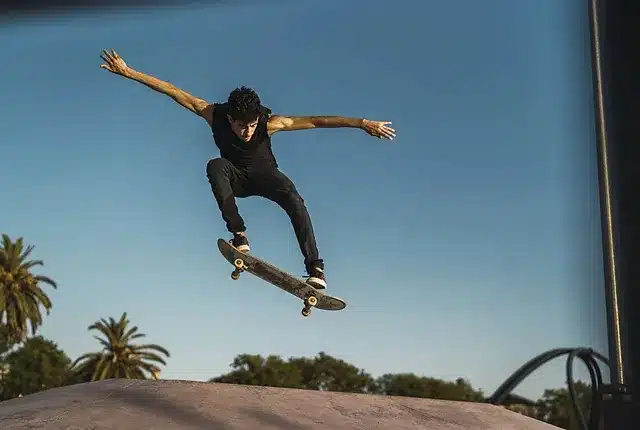Whether you’re drawn to the rhythmic hum of wheels on pavement learning how to skateboard is a vibrant skill most people seek to have.
In this article, we would explore the essential tips and tricks that transform four wheels and a board into a canvas for personal expression and exhilarating experiences.
Let’s dive right in!
Table of contents
- How do I choose the right skateboard for a beginner?
- What safety gear do I need when learning to skateboard?
- How to Skateboard- Step by step guide
- #1. Choose the Right Skateboard:
- #2. Safety First:
- #3. Find Your Stance:
- #4. Practice Balance:
- #5. Learn to Push:
- #6. Master the Kickturn:
- #7. Ollie Basics:
- #8. Kickflip and Heelflip (Optional):
- #9. Riding on Ramps (Optional):
- #10. Skatepark Exploration:
- #11. Stay Consistent:
- #12. Embrace Falls and Get Back Up:
- #13. Learn Skatepark Etiquette:
- Conclusion
- Frequently Asked Questions
- References
- Recommendations
How do I choose the right skateboard for a beginner?
Choosing the right skateboard for a beginner is crucial for a positive learning experience. Here are some tips to help you make the right choice:
Complete Skateboard vs. Custom Build:
For beginners, it’s often recommended to start with a complete skateboard. These come pre-assembled with components that are well-matched for beginners. As you progress, you can explore customizing your setup.
Deck Size:
The width of the skateboard deck is a critical factor. For beginners, a deck width between 7.5 inches and 8.25 inches is a good starting point. Choose a size that feels comfortable for your feet and provides stability.
Truck Size:
Match the truck width to the deck width. Trucks that are too narrow or too wide for the deck can affect stability and maneuverability. A general guideline is to select trucks that are close to the width of your deck.
Wheel Hardness and Size:
For street and park skating, choose medium-sized wheels (50-55mm) with a durometer (hardness) around 95A. Softer wheels provide better grip, while harder wheels slide more easily.
Deck Material:
Most skateboards feature decks made of maple wood, known for its durability and flexibility. Quality decks are usually made of multiple plies of wood, ensuring strength.
Brand Reputation:
Stick to reputable skateboard brands. Well-known brands often have quality control measures in place, ensuring that the components are reliable and suitable for beginners.
Budget Considerations:
While it’s tempting to opt for the cheapest option, investing a bit more in a quality skateboard can make a significant difference in performance and durability. A good skateboard will provide a better overall experience.
See also: How Tall is Jack Skellington? All the Facts and Details
What safety gear do I need when learning to skateboard?
When learning to skateboard, it’s crucial to prioritize safety. Here’s a list of essential safety gear for skateboard beginners:
Helmet:
A certified skateboard helmet is a non-negotiable safety essential. It protects your head in case of falls and reduces the risk of serious injury.
Knee Pads:
Knee pads provide protection for your knees during falls or when attempting tricks. Look for pads with a hard plastic cap for effective impact absorption.
Elbow Pads:
Elbow pads protect your elbows from abrasions and impacts. Like knee pads, they typically have a hard plastic outer shell and foam padding.
Wrist Guards:
Wrist guards are essential for protecting your wrists during falls, especially when learning to balance and perform tricks. They are designed to reduce the risk of wrist sprains or fractures.
Padded Gloves:
Padded gloves can provide additional protection for your hands and fingers. They are especially helpful for beginners who may use their hands to break a fall.
Closed-Toe Shoes:
Wear sturdy, closed-toe shoes with good traction. Skate shoes with flat soles and reinforced areas are designed to provide better grip on the skateboard and protect your feet.
Mouthguard (Optional):
While not as common as other safety gear, a mouthguard can protect your teeth and jaws during falls. It’s particularly relevant if you’re attempting more advanced tricks or ramps.
Protective Clothing:
Consider wearing long sleeves and pants to protect your skin from abrasions. Some skateboarders also wear padded shorts for extra protection.
Reflective Gear (for night skating):
If you skate at night, wear reflective clothing or accessories to enhance your visibility to others, especially if you’re near roads.
Read also: 26 Legitimate Ways to Get a Costco Student Membership for Free
How to Skateboard- Step by step guide
Learning to skateboard involves mastering fundamental skills and gradually progressing to more advanced maneuvers. Here’s a step-by-step guide to help you navigate the urban sport learning curve:
#1. Choose the Right Skateboard:
Select a complete skateboard suitable for beginners. Ensure the deck width, trucks, wheels, and bearings are well-matched. Opt for a comfortable deck size and quality components.
#2. Safety First:
Always wear protective gear, including a certified helmet, knee pads, elbow pads, wrist guards, and closed-toe shoes. Safety gear is essential to prevent injuries during falls.
#3. Find Your Stance:
Determine whether you’re more comfortable with a regular or goofy stance. Your dominant foot (the one you kick a ball with) is usually at the back of the board.
#4. Practice Balance:
Stand on the skateboard with your feet shoulder-width apart. Practice balancing on a flat, smooth surface. Get comfortable shifting your weight from heel to toe.
#5. Learn to Push:
Practice pushing off with your back foot to propel the skateboard forward. Keep your front foot over the front bolts and your weight centered.
#6. Master the Kickturn:
Learn the kickturn by pivoting the front trucks while lifting the front wheels off the ground. This fundamental maneuver helps you navigate turns and obstacles.
#7. Ollie Basics:
Begin practicing the ollie, a fundamental skateboarding trick. Start by mastering the motion of popping the tail and sliding your front foot up the grip tape to level the board in the air.
Check out: What Do Guys Like to Be Called? (Top 25 Names)
#8. Kickflip and Heelflip (Optional):
Progress to more advanced tricks like the kickflip and heelflip once you’ve mastered the ollie. These tricks involve flipping the skateboard while airborne.
#9. Riding on Ramps (Optional):
If you’re interested in ramp skating, start with basic ramps. Learn to drop in, pump, and perform basic tricks like rock to fakie and axle stalls.
#10. Skatepark Exploration:
Visit a local skatepark to practice your skills in a controlled environment. Observe other skateboarders, ask for advice, and gradually challenge yourself with new features.
#11. Stay Consistent:
Skate regularly to build muscle memory and improve your skills. Consistency is key to mastering tricks and feeling confident on the skateboard.
#12. Embrace Falls and Get Back Up:
Falling is part of the learning process. Learn to fall safely, and when you do fall, get back up and try again. Resilience is crucial in skateboarding.
Read also: What Does GMS Mean on Snapchat?
#13. Learn Skatepark Etiquette:
Familiarize yourself with skatepark etiquette, including waiting your turn, being aware of others, and respecting the space.
Conclusion
Learning to skateboard is a thrilling venture into a world of perpetual motion and boundless expression. The urban sport learning curve is an odyssey of resilience, balance, and mastering the dance between gravity and grace.
Check out:: 26 Legitimate Ways to Get a Costco Student Membership for Free
Frequently Asked Questions
For beginners, opt for a complete skateboard setup from a reputable brand. Look for a deck that suits your size, trucks that match the deck width, wheels suitable for street or park skating, and bearings with a moderate ABEC rating for smooth rides.
Essential safety gear includes a certified helmet, knee pads, elbow pads, and wrist guards. These protectors provide a crucial layer of defense as you navigate the learning curve and build your skills.
Start by practicing on flat, smooth surfaces. Stand with your feet shoulder-width apart, knees slightly bent, and distribute your weight evenly. Experiment with weight shifts and practice pushing off gently to develop a sense of balance.
Begin with fundamental tricks like the ollie, the kickturn, and the manual. Mastering these basics builds a strong foundation for more advanced tricks as you progress in your skateboarding journey.
Falling is a part of learning to skateboard, but you can ease the fear by starting with low-risk maneuvers and practicing in a controlled environment. Wearing protective gear also boosts confidence, allowing you to embrace the learning process with greater resilience.
References
- citylegends.io– How to Skateboard
- blog.urbansportsclub.com– How to Skateboard
- redbull.com– How to Skateboard- beginner guide






